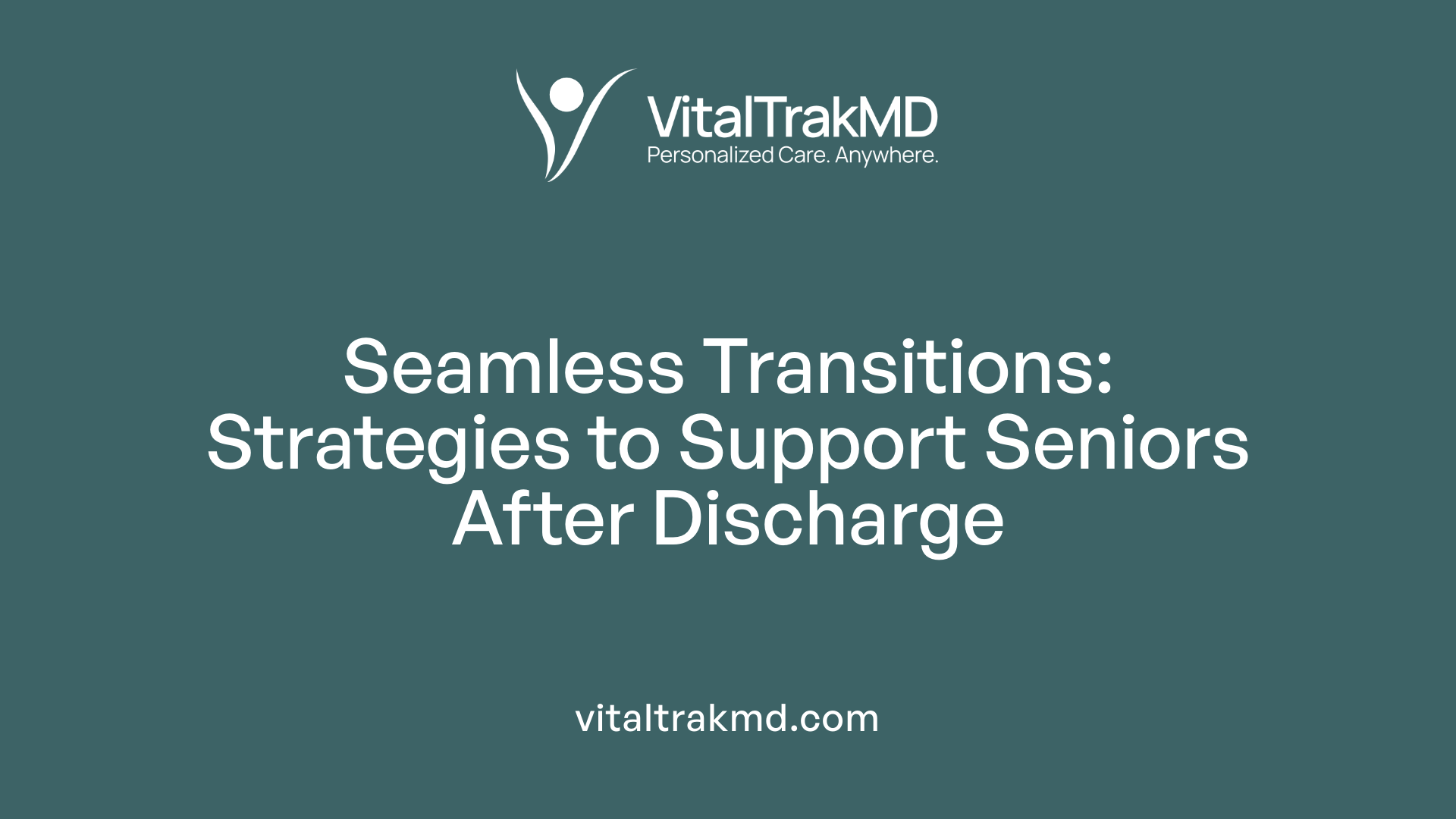How Hybrid Care Supports Post-Surgery Recovery in Seniors

Innovative Solutions for Senior Recovery Post-Surgery
As the global population ages, ensuring effective and safe post-surgical recovery for seniors has become a priority for healthcare providers. Hybrid care models—integrating in-person, remote, and technological approaches—are emerging as promising strategies to support elderly patients through the critical recovery period. These models not only enhance safety and satisfaction but also reduce hospital stays and overall healthcare costs, offering patient-centered solutions amid increasing surgical demands among older adults.
Understanding Hybrid Care Models in Post-Surgical Recovery for Seniors

What are hybrid care models for supporting post-surgery recovery in seniors?
Hybrid care models are innovative approaches that blend in-person healthcare services with digital health technologies to support seniors after surgery. These models aim to deliver hospital-level care within the comfort of patients' homes or community-based settings. By integrating remote monitoring, virtual check-ins, telehealth consultations, and in-home nursing support, they provide comprehensive and personalized care.
A typical example is the hospital-at-home program, exemplified by Mayo Clinic's Advanced Care at Home (ACH), which combines virtual provider oversight with in-home treatment to manage complex cases safely. Similar models include the 'Care Hotel' at Mayo Clinic Florida, where patients receive in-person and virtual care in an out-of-hospital environment, and the virtual hybrid hotel care that leverages technology for continuous monitoring.
These models have shown remarkable effectiveness in ensuring safe recovery by reducing complications like infections, supporting pain management, and facilitating physical therapy and medication adherence. They also reduce healthcare costs by decreasing hospital stay durations, minimizing risks of hospital-acquired conditions, and easing hospital capacity issues.
Importantly, hybrid models prioritize patient satisfaction, emotional well-being, and tailored care plans, making recovery more comfortable and less stressful. They also enable rapid response to emerging health needs, promoting quicker recovery times and better functional outcomes.
In summary, hybrid care models are reshaping post-surgical recovery pathways for seniors by offering safer, cost-effective, and patient-centered alternatives to traditional inpatient care, especially vital during times of health system strain or for individuals with complex health conditions.
Components and Implementation of Hybrid Post-Surgical Care

What components are involved in hybrid post-surgical care for seniors?
Hybrid post-surgical care for seniors incorporates a variety of elements designed to support effective recovery outside traditional hospital environments. It primarily relies on a multidisciplinary approach, blending in-person clinical care with technological innovations such as telehealth and remote monitoring.
Telehealth consultations allow healthcare providers to conduct virtual follow-ups, assess recovery progress, and quickly address any complications. Remote monitoring technologies, including wearable sensors and connected devices, track vital signs, wound healing, and other health indicators, providing continuous oversight without the need for frequent hospital visits.
In addition to technological tools, transitional services play a crucial role. These include home-based rehabilitation programs tailored to the individual’s condition, educational support on wound, implant, or device care, and regular follow-up appointments that extend into the post-discharge period.
The comprehensive approach also emphasizes lifestyle and behavioral modifications. This involves maintaining excellent oral hygiene with gentle brushing, use of prescribed mouthwashes, and cleaning tools like interdental brushes to prevent bacterial buildup.
Dietary restrictions are tailored to support healing, avoiding hard, hot, or cold foods, and limiting sugar intake to foster proper tissue integration and prevent infections. Seniors are advised to steer clear of activities that might hinder recovery, such as strenuous physical exertion, trauma-inducing movements, smoking, and use of straws.
Overall, these components work together to ensure a safe, monitored, and supportive environment that promotes healing while minimizing hospital readmissions and enhancing patient satisfaction.
Implementation methods including multidisciplinary teams and technology use
The success of hybrid post-surgical care hinges on collaborative efforts among diverse healthcare professionals. Multidisciplinary teams typically include surgeons, primary care physicians, nurses, physiotherapists, and sometimes social workers or patient educators.
These teams coordinate care by creating personalized recovery plans, leveraging telehealth platforms for regular check-ins, and utilizing remote monitoring devices to gather real-time health data. The integration of technology facilitates prompt intervention if any signs of complications emerge, such as infection, bleeding, or impaired mobility.
Implementation also involves establishing clear communication channels and educational resources to empower patients and caregivers. Mobile health applications and websites serve as platforms for delivering tailored information, medication reminders, and direct contact with healthcare providers.
Successful deployment depends on organizational support from healthcare institutions, investment in reliable telemedicine infrastructure, and training for staff and patients to use technology effectively.
Examples of successful hybrid programs
One notable example is the Mayo Clinic's
Transitional Care and Post-Discharge Support Strategies

What are transitional care and post-discharge support strategies in hybrid care models?
Transitional care and post-discharge support strategies in hybrid care models are structured approaches aimed at maintaining continuity of care as patients move from hospital settings back to their homes or another care environment. These strategies are designed to ensure a seamless transition, reducing the risk of complications, readmissions, and functional decline.
A central element of these strategies is the deployment of multidisciplinary care teams that include nurses, therapists, social workers, and physicians. These teams coordinate services such as home visits, virtual follow-ups via telehealth, medication management, wound care, and rehabilitation therapies—physical, speech, or occupational—depending on patient needs. For example, a patient recovering from surgery might receive scheduled home visits to monitor wound healing, combined with virtual check-ins for ongoing assessment.
Technology plays a pivotal role in hybrid models. Biometric devices, remote monitoring tools, and video consultations allow healthcare providers to keep a real-time eye on vital signs, pain levels, and other health indicators, providing high-quality hospital-level oversight within the comfort of the patient's home. Such systems facilitate quick responses to emerging issues, ensuring optimal timing of interventions.
Programs like the Mayo Clinic's Advanced Care at Home and WPH Cares exemplify effective hybrid care. They show decreased hospital readmissions, heightened patient satisfaction, and improved recovery rates. By enabling continuous, real-time monitoring and rapid communication between patients and care teams, these models aim to accelerate healing, prevent post-surgical complications, and better support the emotional and physical needs of patients.
Overall, these hybrid strategies emphasize personalized, technology-enabled care, promoting quicker recovery, minimizing risks, and making efficient use of healthcare resources in the critical post-discharge period.
| Aspect | Description | Additional Details |
|---|---|---|
| Care Delivery Methods | Home visits, telehealth follow-ups, in-home therapies | Ensuring accessible, consistent support for functional recovery and complication prevention |
| Technology Use | Biometric devices, video consultations, remote monitoring | Facilitating real-time health tracking and rapid intervention |
| Patient Population | Post-surgical, elderly, those with complex chronic conditions | Tailored to meet diverse needs across different care levels |
| Program Examples | Mayo Clinic ACH, WPH Cares | Demonstrate improved outcomes, patient satisfaction, and resource efficiency |
| Benefits | Reduced readmissions, enhanced recovery, patient-centered care | Focused on safety, convenience, and quality of life |
In sum, transitional care and post-discharge support strategies in hybrid care models are transforming the way health systems manage patient recovery, with a focus on safety, efficiency, and personal experience.
Effectiveness and Outcomes of Hybrid Healthcare Solutions
How effective are hybrid healthcare solutions for seniors recovering after surgery?
Hybrid healthcare solutions have proven to be highly effective for seniors in post-surgery recovery. These models seamlessly combine in-home care with digital health technologies such as telemedicine, wearable devices, and artificial intelligence to offer personalized and continuous support.
By integrating remote monitoring tools, healthcare providers can track vital signs, wound healing, and functional progress in real-time. This early data allows for quicker responses to potential complications, such as infections or blood clots, which is crucial for older adults who may have multiple health conditions.
One notable example is the Mayo Clinic’s Advanced Care at Home (ACH) program, which delivers hospital-level care directly to patients’ homes. This program utilizes virtual providers and in-home personnel, enabling comprehensive care for complex cases, including elderly patients with multiple comorbidities. A typical case involved a 76-year-old patient who underwent total knee arthroplasty and was monitored closely through virtual rounds and continuous health tracking. The patient was discharged on postoperative day 15 with no complications, showcasing the safety and feasibility of home recovery for seniors.
Further support comes from the 'Care Hotel' program at Mayo Clinic Florida, which offers outpatient post-operative care in a comfortable, out-of-hospital setting combining in-person and virtual visits. Out of 392 patients, nearly 70% chose this model, with a median age of 61.5 years, indicating its suitability for an older population. Patients with mild to severe systemic diseases benefited from this adaptable approach across multiple specialties, including urology and electrophysiology.
These hybrid models result in substantial benefits, including reduced hospital stays and lower risk of hospital-acquired infections. They also tend to improve patient satisfaction, as recovery occurs in a familiar environment with tailored virtual support, familiar faces, and flexible scheduling. Studies report high acceptance rates among seniors and their families, emphasizing comfort and convenience.
In addition, cost savings are significant. Hospital-at-home programs decrease inpatient days, lowering the burden on healthcare systems and reducing expenses associated with prolonged hospital stays. These models align with a broader shift toward patient-centered care, emphasizing safety, comfort, and tailored support.
Multiple research efforts reinforce these positive outcomes. For instance, ongoing clinical trials are examining whether structured physical rehabilitation within hybrid models can prevent long-term functional and cognitive decline, particularly in elderly patients following urgent surgeries. They also assess the cost-effectiveness of such interventions, including improved quality of life and lowered healthcare resource utilization.
In conclusion, hybrid healthcare solutions, through their integrated, technology-enabled approach, are proving to be effective ways to support seniors in recovery after surgery. They combine medical safety, patient satisfaction, and cost-effectiveness, ultimately transforming postoperative care for older adults.
| Program Type | Population Served | Main Benefits | Key Examples |
|---|---|---|---|
| Advanced Care at Home | Complex cases, including elderly | Reduced hospital stays, continuous monitoring | Mayo Clinic ACH, 76-year-old knee patient |
| Care Hotel | General outpatient post-op patients | High acceptability, flexibility, and safety | Mayo Clinic Florida, 392 patients |
| Hybrid Cardiac Rehab | Elderly cardiac patients | Increased participation, early mobilization | Mobile health apps, sensor-based programs |
The expanding use of hybrid healthcare models underscores their potential to redefine recovery pathways, especially for vulnerable seniors, by blending technology with compassionate, personalized care.
Practical Applications of Hybrid Care in Senior Postoperative Support

What practical applications does hybrid care have in supporting seniors after surgery?
Hybrid care plays an increasingly vital role in supporting older adults following surgery, offering innovative solutions that blend technology with personalized care strategies. One of the primary applications is remote monitoring, which involves continuous virtual supervision of vital signs, wound status, and medication adherence. This allows healthcare providers to promptly identify and respond to potential complications, reducing the need for frequent hospital visits.
Tele-rehabilitation forms another cornerstone of hybrid care. It provides elderly patients with tailored exercise programs, educational resources, and direct communication with physiotherapists through digital platforms. This keeps seniors active, engaged, and supported during recovery, all from the comfort of their homes. Evidence shows that tele-rehabilitation not only improves adherence but also enhances functional outcomes and patient satisfaction.
Hospital-at-home programs, such as Mayo Clinic’s Advanced Care at Home (ACH), exemplify integrated models that combine virtual provider oversight with in-home delivery of care. These programs enable complex postoperative management, including pain control, anticoagulation therapy, and physical therapy, to be conducted safely outside traditional facilities. A notable case involved a 76-year-old patient with multiple comorbidities undergoing knee replacement surgery. Through diligent virtual rounds and real-time monitoring, the patient was safely discharged on postoperative day 15 without complications, highlighting the feasibility of home-based recovery for high-risk cases.
Furthermore, hybrid care supports minimally invasive procedures carried out in sophisticated hybrid operating rooms. These advanced surgical environments allow for complex, high-precision interventions that are less traumatic for elderly patients. For example, the use of minimally invasive techniques reduces pain, shortens recovery times, and decreases hospital stay durations.
Integration of personalized care plans with cutting-edge technology allows for adaptive treatment tailored to each patient's medical history, physical condition, and social circumstances. Devices like sensor-based applications, wearable monitors, and communication tools empower patients to participate actively in their recovery, while healthcare teams can adjust interventions based on real-time data.
Overall, hybrid care models such as virtual monitoring, tele-rehabilitation, and hospital-at-home programs exemplify how combining technology with flexible, patient-centered strategies can optimize recovery outcomes, enhance safety, and improve quality of life for seniors after surgery.
Role of Telehealth and Digital Health in Hybrid Post-Surgical Support
How are telehealth and digital health interventions used in hybrid post-surgical care for seniors?
In the realm of post-surgical recovery for seniors, telehealth and digital health tools have become indispensable components of hybrid care models. These interventions are designed to streamline monitoring, enhance communication, and provide comprehensive support, all while allowing patients to recover comfortably at home.
Remote consultations are a cornerstone of these digital strategies. Through telemedicine platforms, healthcare providers can conduct follow-up appointments, assess wound healing, and address patient concerns without the need for physical visits. This approach is especially beneficial for seniors who may face mobility challenges or live in remote areas. It reduces hospital readmissions and emergency visits by enabling timely interventions.
Wearable devices and sensors play a critical role in continuous health monitoring. Devices such as smart bands, implantable sensors, and smart bandages track vital signs, wound status, and early signs of complications like infections or blood clots. These tools transmit real-time data to healthcare teams, allowing for prompt responses if abnormal patterns are detected.
Digital patient education platforms, including mobile apps and online portals, foster better engagement and adherence. They provide tailored instructions, reminders for medication and exercises, and educational content that empower seniors to actively participate in their recovery. Such tools also support mental well-being by reducing anxiety and enhancing confidence in managing their health.
The integration of artificial intelligence and predictive analytics further amplifies the benefits of digital interventions. These technologies analyze data from wearables and virtual check-ins to identify potential risks early, guiding personalized care plans and preventing complications.
Overall, telehealth and digital health interventions have transformed post-surgical care for seniors, making it more efficient, personalized, and accessible. They help bridge the gap between hospital and home, ensuring safe, effective, and comfortable recovery experiences for elderly patients.
Supporting Caregivers and Enhancing Patient Experience

What is the role of family involvement in post-surgical care for seniors?
Family members and informal caregivers play a crucial role in supporting seniors after surgery, especially when recovery occurs at home. Their involvement includes assisting with daily activities such as bathing, grooming, meal preparation, and light housekeeping. Caregivers also monitor the patient's health for signs of complications like infections or blood clots, ensuring medication adherence and wound care are properly managed.
Emotionally, family support helps boost the patient’s mental well-being, providing reassurance and a sense of security. Engaged families can help motivate seniors to adhere to physical therapy routines and foster a positive environment conducive to healing.
Furthermore, family members often act as communication links between healthcare professionals and the patient, relaying vital information and ensuring care plans are followed. This collaborative approach enhances safety, accelerates recovery, and improves overall satisfaction with the care process.
How do educational resources and support programs aid in postoperative recovery?
Educational materials and support programs are essential in empowering caregivers and patients with knowledge about recovery expectations and care procedures. Resources such as instruction booklets, videos, and virtual training sessions help caregivers understand wound management, medication schedules, mobility exercises, and signs of potential complications.
Support programs, including telehealth consultations and home visits by healthcare professionals, offer ongoing guidance, answer questions, and troubleshoot issues as they arise. These initiatives reduce caregiver anxiety and ensure proper management of the patient's health outside clinical settings.
Technological solutions, such as mobile apps and remote monitoring devices, facilitate real-time data sharing with medical teams, enabling prompt response to any concerns. Overall, comprehensive education and support foster confidence, competence, and consistency in at-home care.
What strategies are effective in addressing caregiver burden and wellbeing?
Caregiver burden refers to the physical, emotional, and financial stresses that caregivers experience, which can impact their health and the quality of care they provide. Recognizing these challenges, effective strategies include providing accessible training, emotional support, and respite services.
Support groups and counseling services can help caregivers cope with stress and share experiences, reducing feelings of isolation. Structured programs that include periodic check-ins by healthcare teams enable caregivers to express concerns and seek advice.
Interventions such as self-management education, telehealth support, and family-centered care models increase caregiver confidence and reduce uncertainties. Ensuring caregivers have access to practical resources like equipment for safe mobility and home modifications also alleviates physical strain.
Promoting caregiver wellbeing is vital for sustainable, safe, and effective at-home recovery for seniors. Providing financial assistance information and coordinating community resources further supports caregiver resilience.
| Aspect | Focus | Benefits |
|---|---|---|
| Family Involvement | Daily support, emotional encouragement, communication | Improved recovery, higher satisfaction, safety |
| Educational Resources | Instructional materials, virtual support, remote monitoring | Better adherence, early complication detection |
| Caregiver Wellbeing | Support groups, respite care, emotional counseling | Reduced stress, sustained caregiving ability |
Best practices for supporting seniors after surgery at home
Supporting seniors after surgery at home involves a comprehensive approach that prioritizes safety, education, and emotional support. Creating a safe environment means removing hazards, installing safety devices, and ensuring accessibility tailored to individual needs.
Prior consultation with healthcare providers is vital to develop a personalized care plan that addresses medication management, wound care, and activity restrictions. Engaging professional home care services, including skilled nursing and physical therapists, can enhance recovery by providing specialized support.
Regular check-ins, either virtually or in person, help monitor progress and promptly address any emerging concerns. Family involvement, combined with reliable educational resources, empowers caregivers and patients alike.
Activities promoting movement, emotional connection, and routine can bolster healing and mental health. Ultimately, an integrated care approach involving healthcare teams, caregivers, and the patient fosters a safe, effective, and satisfying recovery journey at home.
Future Directions and Opportunities in Hybrid Post-Surgery Care
How effective are hybrid healthcare solutions for seniors recovering after surgery?
Hybrid healthcare solutions are proving to be highly effective for seniors recovering from surgery. These models combine in-home care with digital health tools, leading to continuous, personalized support that can adapt to each patient's needs. Technologies such as telemedicine platforms, wearable sensors, biofeedback devices, and artificial intelligence enable remote health monitoring and real-time guidance, reducing the need for frequent hospital visits.
For example, the Mayo Clinic's Advanced Care at Home (ACH) program uses virtual providers along with in-home care delivery, allowing high-acuity hospital-level care at home. This approach was successful in complex cases, such as a 76-year-old patient recovering from total knee arthroplasty, who was discharged without complications after diligent virtual monitoring.
Studies in postoperative rehabilitation, including cardiac and abdominal surgeries, show that hybrid models like the 'Care Hotel'—an out-of-hospital environment combining in-person and virtual care—are widely accepted and effective across various surgical specialties. These programs improve functional recovery, reduce hospital stays, and enhance patient satisfaction, especially among older adults with chronic or severe systemic diseases.
The integration of high-intensity training methods, like the i-STRONGER program, underscores the potential to enhance mobility and independence through remote supervision. This indicates that well-structured hybrid care solutions can significantly boost recovery outcomes, decrease readmission rates, and improve overall quality of life for seniors.
When supported by robust technological infrastructure and appropriate policies, these models can provide safer, more accessible, and efficient care, ultimately transforming the landscape of postoperative recovery for older individuals.
What innovations in technology and care models are shaping future post-surgical recovery?
The future of hybrid post-surgery care will be driven by several technological and structural innovations. Advanced wearable sensors and mobile apps will facilitate continuous monitoring of vital signs, mobility, and wound healing, allowing early detection of complications such as infections or blood clots.
Artificial intelligence and machine learning algorithms will analyze vast amounts of health data to personalize care plans, predict risks, and automate alerts for healthcare providers. Virtual reality and biofeedback systems may also be incorporated to assist in pain management and physical therapy, making rehab exercises more engaging and effective.
Care models will become more flexible, offering a seamless blend of in-person visits, telehealth consultations, and remote monitoring. This hybrid approach fosters patient autonomy and empowers family caregivers, who will play an increasingly integral role through digital communication tools.
The development of specialized platforms, such as the older adult-friendly 'Care Hotel', emphasizes creating comfortable and safe environments where patients can receive comprehensive care outside traditional hospitals. These environments will leverage IoT (Internet of Things) technology for environmental safety, medication management, and activity tracking.
Furthermore, integrative programs like early mobile health interventions in cardiac rehab demonstrate how tailored, technology-enabled solutions motivate seniors to stay active and engaged during recovery.
What policy and funding considerations are necessary to expand these models?
To effectively expand hybrid post-surgery care, policymakers need to address several funding and regulation challenges. Insurance coverage, including Medicare and Medicaid, must evolve to reimburse telehealth services, remote monitoring, and home-based interventions fairly and sustainably.
Regulatory frameworks should ensure the safety, quality, and privacy of digital health tools while promoting innovation. This could involve establishing standards for data security, device interoperability, and evidence-based practice guidelines.
Funding strategies such as grants, subsidies, or pay-for-performance models can incentivize healthcare providers and technology companies to develop and adopt advanced hybrid models. Investment in broadband infrastructure and digital literacy programs is critical to bridging the digital divide, especially among older, underserved populations.
Collaboration among healthcare providers, technology developers, insurers, and policymakers will be crucial to creating integrated systems that support scalable, personalized, and equitable post-surgical care.
What research is needed and how can future improvements be made?
Ongoing research should focus on robust clinical trials comparing hybrid care models with traditional approaches to better understand their impact on outcomes like functional status, cognitive health, and quality of life.
Investigating cost-effectiveness, patient satisfaction, and caregiver burden will inform resource allocation and program optimization.
Research should also explore technological innovations, identifying which tools and strategies most effectively promote engagement, safety, and recovery among seniors.
Further, developing predictive analytics to customize interventions based on individual risk profiles can enhance effectiveness.
In the future, embedding patient and caregiver feedback into the design and evaluation of hybrid models will ensure these solutions remain user-centered.
Overall, continued collaborations across clinical, technological, and policy domains will foster improvements that make post-surgical recovery safer, faster, and more patient-centered.
| Aspect | Current Status | Future Focus | Additional Notes |
|---|---|---|---|
| Technology | Telemedicine, wearables, AI | VR, biofeedback, IoT | Enhancing remote monitoring and personalization |
| Care Models | Hybrid hospitals, 'Care Hotel' | Flexible, integrative platforms | Seamless blend of in-person and virtual care |
| Policy | Reimbursement policies evolving | Standardized regulations, coverage expansion | Promoting equitable access and safety |
| Research | Ongoing clinical trials | Long-term outcomes, caregiver impact | Incorporating patient and caregiver feedback |
With continued innovation, supportive policies, and focused research, the future of hybrid post-surgery care for seniors holds the promise of safer, more effective, and more accessible recovery pathways.
Embracing Hybrid Care for Better Elderly Recovery
The integration of hybrid care models into post-surgical recovery for seniors represents a transformative shift in healthcare delivery. By combining traditional medical approaches with innovative telehealth, remote monitoring, and patient-centered strategies, these models have demonstrated significant benefits, including improved safety, reduced hospital stays, higher satisfaction, and better clinical outcomes. Given the growing aging population and the complexity of post-operative needs, healthcare systems should prioritize the development and support of hybrid solutions. Embracing these models ensures a more resilient, efficient, and compassionate approach to elderly care, ultimately enabling seniors to recover at home safely, comfortably, and with dignity.
References
- Acute postoperative and rehabilitation care managed in a virtual ...
- A Virtual Hybrid Care Hotel Model Supports the Recovery of Post ...
- A Virtual Hybrid Care Hotel Model Supports the Recovery of Post ...
- Interventions to support caregivers of older adults undergoing surgery
- Postoperative physical rehabilitation in the elderly patient after ...
- What is Transitional Care?: Everything You Need to Know
- Getting help after hospital discharge - Care & support - Age UK
Recent articles
Want to Feel Better and Live Healthier?
Join hundreds of patients taking control of their health with personalized care that fits their life – not the other way around.
Rated 4.8/5 by 32+ customers







